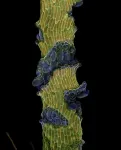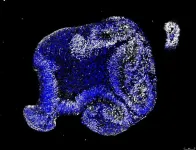(Press-News.org) An obscure aquatic plant has helped to explain how plants avoid cracking up under the stresses and strains of growth.
The finding by researchers Dr Robert Kelly-Bellow and Karen Lee in the group of Professor Enrico Coen at the John Innes Centre, started with a curious observation in a dwarf mutant of the carnivorous plant Utricularia gibba.
The stems of this floating plant are filled with airspaces and this hollowness means that the vascular column inside the stem can buckle when under stress. This effect would not be apparent in most plants, which have solid stems.
The researchers saw that in a dwarf mutant the central column was wavy instead of straight. They hypothesised that this wobbly spine was caused by an internal conflict, a disparity between what was happening inside the plant stem and the epidermis or skin. Computational modelling by coauthor Dr Richard Kennaway showed this idea could account for what was observed.
“We realized that in these types of dwarf, only the epidermis, the skin of the stem, wants to be short, the internal tissue still wants to be long hence the buckling effect,” explains Professor Enrico Coen of the John Innes Centre, an author of the study which appears in Science.
“This was a surprise - previously people had thought that dwarf varieties, which are very important in agriculture, would be dwarf because everything in the stem is affected to grow less but in fact it's just the skin in this case, creating a sort of straitjacket.”
Further investigations revealed that the Utricularia gibba dwarf mutant lacked a growth hormone called brassinosteroid.
They theorized that this hormone normally allows the skin to stretch, giving a more forgiving straitjacket and allowing the plant stem to elongate.
To test this idea, they used a mutant in the model plant Arabidopsis that weakens the glue between cells, to see if reducing brassinosteroid would cause major cracks to form in the skin of the stem as a result of the stresses.
“That is exactly what we saw," explains Professor Coen. “Normally an Arabidopsis stem with weakened glue will crack slightly because the hormone is there to loosen the straitjacket. But when the hormone was missing, the skin was completely ripped off and the plant was almost skinless.”
Computational modelling by coauthor Professor Richard Smith showed brassinosteroid hormone was likely easing the straitjacket by loosening fibres in the epidermal cell walls.
“Plant cells are stuck together and are forced to behave in a coordinated way just by their pectin, their glue, that binds them. What we show in this study is that this is an incredibly powerful force; the glue is so strong you only need to change growth in one layer and the other cells will follow,” explains Professor Coen.
“Previous studies have emphasised that plants send molecular signals to grow in a coordinated way, and this is still a part of the explanation. But what our study shows is that the glueyness of plant cells is also a vital component in coordinating growth. Sticking together is very important.”
Coauthor Dr Christopher Whitewoods at the Sainsbury Laboratory, Cambridge University, emphasizes the potential importance of these findings for future research. “The fact that mechanical interactions between cell layers control growth in the stems of two wildly different species raises the question of whether they control other aspects of plant development, such as the complex internal patterning of leaves. We are excited to test whether this is the case”.
The findings shed light on dwarfing varieties of crops, like wheat and rice, which underpin agriculture’s Green Revolution, explaining how genes control their growth and how we might improve their efficiency in future.
Their findings also relate to developmental processes in animals, such as formation of crocodile skin cracks and shaping of the intestine, where mechanical interactions between layers are also thought to play a part.
Many hypotheses look promising to begin with but then fail to last the full experimental course. Not so in this case, reflects Professor Coen.
“The first glimpse of the wobbly tissue in our dwarf aquatic plant was exciting because as soon as we saw that, we had an idea of what might be going on. But the biggest excitement came from testing the idea in a completely different system.
“Nature is elusive. Ninety-nine percent of nice ideas fall flat on their face when put to a critical test. But occasionally an idea survives and you then know that nature has revealed one of its secrets to you,” he says.
Brassinosteroid co-ordinates cell layer interactions in plants via cell wall and tissue mechanics, appears in Science.
END
The clue is in the glue - Nature’s secret for holding it together
2023-06-22
ELSE PRESS RELEASES FROM THIS DATE:
Generative AI models are encoding biases and negative stereotypes in their users
2023-06-22
The likes of ChatGPT, Google’s Bard and Midjourney can also help spread incorrect, nonsensical information
Marginalised groups are disproportionately affected
Children are at particular risk
In the space of a few months generative AI models, such as ChatGPT, Google’s Bard and Midjourney, have been adopted by more and more people in a variety of professional and personal ways. But growing research is underlining that they are encoding biases and negative stereotypes in their users, as well as mass generating and spreading seemingly accurate but nonsensical information. Worryingly, marginalised groups are disproportionately affected by the fabrication of this nonsensical information.
In ...
Bringing the power of "multiplex" imaging to clinical pathology
2023-06-22
June 22, 2023, NEW YORK – Researchers at the Ludwig Center at Harvard have developed a platform technology for imaging that enables integration of the methods of microscopic analysis long employed in pathology laboratories with the visualization of multiple molecular markers in individual cells that is now rapidly advancing in research labs. The latter capability, known as “multiplex” imaging, promises to revolutionize cancer diagnostics by exposing molecular traits associated with ...
NF researchers, clinicians and patients gather for annual conference in Scottsdale
2023-06-22
From June 21 through June 27, the largest gathering of NF researchers, clinicians, and patients in the world will take place at the Fairmont Scottsdale Princess in Scottsdale, Arizona. NF is a group of genetic disorders that causes tumors to grow on nerves throughout the body, and affects 1 in 2,000 births of all populations equally. As such, NF affects millions worldwide, but is underrecognized. While there is one approved treatment for a small subgroup of NF patients with plexiform neurofibromas, there is no cure yet, and the vast majority of NF patients face serious health issues because of the condition. ...
Argonne installs final components of Aurora supercomputer
2023-06-22
The installation of Aurora’s 10,624th and final “blade” marked a major milestone for the highly anticipated exascale supercomputer at the U.S. Department of Energy’s (DOE) Argonne National Laboratory.
After years of diligent work and planning, the system now contains all the hardware that will make it one of the most powerful supercomputers in the world when it is opened up for scientific research. Built by Intel and Hewlett Packard Enterprise (HPE), Aurora will be theoretically capable ...
Being able to tell parents about sexuality plays important role in mental health of Black sexual minority men and transgender women
2023-06-22
Black sexual minority men (BSMM) and transgender women (BTW) face racial and sexuality-based discrimination, and disproportionately high depression compared to Black heterosexual men and Black cisgender women, respectively. Though previous studies have demonstrated the relationship between discrimination and depression among racial and sexual minorities, few studies explore the extent to which openness with parents impacts this relationship.
A new study by College of Public Health Assistant Professor Rodman Turpin found that sexual identity ...
Transforming Anthropology joins the University of Chicago Press journals program in 2024
2023-06-22
We are honored to announce that Transforming Anthropology will join the University of Chicago Press journals program beginning in 2024 (vol. 32, no. 1). Transforming Anthropology is the flagship journal of the Association of Black Anthropologists (ABA), which is a section of the American Anthropological Association (AAA). All 8,000+ members of the AAA receive online access to Transforming Anthropology through their membership, and that benefit will continue in this new partnership.
“Thanks to the vision and dedication of our editor, Aisha Beliso-De Jesús, the journal will maintain its tradition of supporting and nurturing ...
Lehigh Industrial Assessment Center to expand into regional energy audit, workforce development role
2023-06-22
The Lehigh University Industrial Assessment Center (IAC) will expand into the Mid-Atlantic Regional IAC Center of Excellence (MARICE) with newly awarded funding from the U.S. Department of Energy (DOE).
Lehigh’s IAC was established in 2001 as part of the DOE’s nationwide Industrial Assessment Center Program to reduce energy and waste and enhance productivity for manufacturing plants in Pennsylvania, New Jersey, and New York. The center, which was most recently renewed in 2021, is led by mechanical engineering and mechanics (MEM) faculty Professor Alparslan ...
Stem cell model of human brain development suggests embryonic origins of Alzheimer’s disease
2023-06-22
Alzheimer's disease (AD) mainly affects the older population. Recent research found early disease signs in cell culture models of early human brain development, raising the possibility that the disease has its origins much earlier in life, possibly during embryogenesis – the formation and development of an embryo.
Alzheimer’s disease is a highly prevalent, debilitating, and potentially fatal neurodegenerative disease with limited treatment options. Patients are typically diagnosed at an advanced disease stage, limiting the possibilities for early therapeutic intervention. Although for most patients ...
Chronic stress-related neurons identified
2023-06-22
Researchers at Karolinska Institutet in Sweden have identified a group of nerve cells in the mouse brain that are involved in creating negative emotional states and chronic stress. The neurons, which have been mapped with a combination of advanced techniques, also have receptors for oestrogen, which could explain why women as a group are more sensitive to stress than men. The study is published in Nature Neuroscience.
Just which networks in the brain give rise to negative emotions (aversion) and chronic stress have long been unknown to science.
By using ...
Highest honor in Antarctic exploration goes to Ian Dalziel
2023-06-22
Ian Dalziel of The University of Texas at Austin has been honored with the Polar Medal — the United Kingdom’s top award for polar exploration. The medal recognizes Dalziel’s contributions to Antarctic geology, including discoveries about the icy continent’s ancient past and the fragility of its ice sheet today. The award will be presented by King Charles III at Buckingham Palace later this year.
Early recipients of the medal, which has existed for more than 150 years, include pioneers of polar exploration Capt. R.F. Scott and Sir Ernest Shackleton, who made the first attempt to reach the South Pole in 1902. Dalziel’s ...




